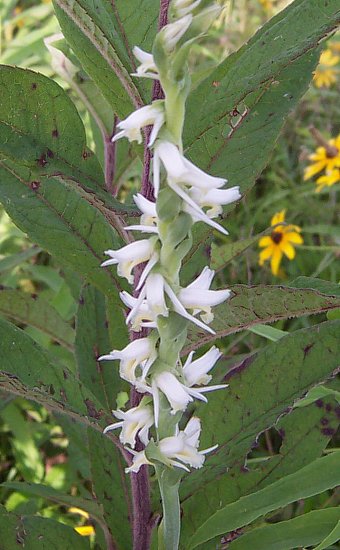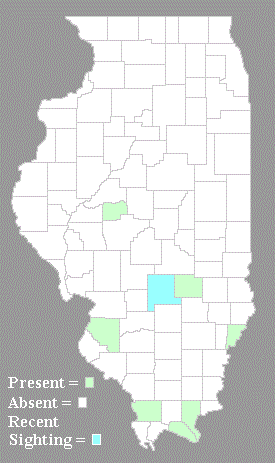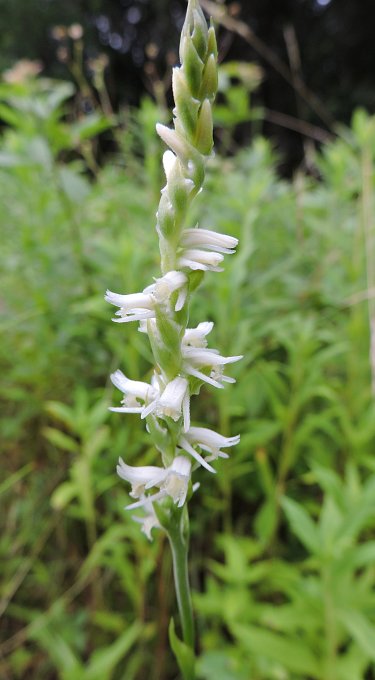 Description:
Initially, this herbaceous perennial plant forms a rosette of 4-7 basal
leaves that are widely spreading to ascending. These basal leaves are
medium green, glabrous, and usually elliptic in shape; they are
longitudinally keeled below (and indented above), while their margins
are entire (toothless). A mature plant bolts during the late spring or
early summer to develop an erect flowering stalk about ¾–2½' (20-75
cm.) tall. Below the rachis of the inflorescence, this stalk is medium
green, terete, glabrous, and up to ¼" (5-6 mm.) in diameter. About 3-5
alternate leaves are located toward the base of the stalk; they are
2-10" (5-25 cm.) long and 4-12 mm. across. These lower leaves are
grass-like in appearance, linear in shape, and entire along their
margins; they sometimes wither away prior to the blooming period. The
upper leaves along the stalk are reduced to little more than sheaths
with lanceolate tips. Above the uppermost leaf, both the peduncle and
rachis of the floral spike are medium green, terete, and
short-pubescent with non-glandular hairs. About 10-40 flowers are
arranged along the rachis in either an open or dense single spiral
(latter sometimes appearing to be 2 spirals). Individual flowers are
6-10 mm. long, their 3 petals and petaloid upper sepal forming a white
tube-like structure with an upper and lower lip. In addition, there are
2 petaloid lateral sepals that are white, linear in shape, and
straight,
rather than arching; they are also slightly declined and diverge
laterally to some extent from the tube-like structure of the flower.
The lower lip of the corolla has crisped margins, while the smaller
upper lip is less crisped. The interior of the lower lip is pale
yellow. There are also solitary bracts at the bases of the flowers.
These bracts are up to ½" long (or slightly longer), ovate with tapered
tips, light green, glabrous, and more or less erect, curving to
the side of the flowers. The flowers are slightly ascending, widely
spreading, or slightly descending, and their tubular structures are
arch slightly downward. At the base of the lower lip within each
flower, there is
a pair of minute calli (protuberances) up to 1 mm. long that are
narrowly lanceoloid and often slightly hooked. In Illinois, the
blooming
period occurs during mid- to late summer, lasting about 3-4 weeks for a
colony of plants. However, this orchid can bloom earlier in the year in
areas that lie south of the state. After the blooming period, the
flowers are replaced by seed capsules about 8 mm. in length that are
broadly ellipsoid in shape; they eventually release their minute seeds
to the wind. The root system is shallow and spreading, consisting of
several fibrous roots that are thick and fleshy. Occasionally, clonal
offsets develop from the tips of these fleshy roots.
Description:
Initially, this herbaceous perennial plant forms a rosette of 4-7 basal
leaves that are widely spreading to ascending. These basal leaves are
medium green, glabrous, and usually elliptic in shape; they are
longitudinally keeled below (and indented above), while their margins
are entire (toothless). A mature plant bolts during the late spring or
early summer to develop an erect flowering stalk about ¾–2½' (20-75
cm.) tall. Below the rachis of the inflorescence, this stalk is medium
green, terete, glabrous, and up to ¼" (5-6 mm.) in diameter. About 3-5
alternate leaves are located toward the base of the stalk; they are
2-10" (5-25 cm.) long and 4-12 mm. across. These lower leaves are
grass-like in appearance, linear in shape, and entire along their
margins; they sometimes wither away prior to the blooming period. The
upper leaves along the stalk are reduced to little more than sheaths
with lanceolate tips. Above the uppermost leaf, both the peduncle and
rachis of the floral spike are medium green, terete, and
short-pubescent with non-glandular hairs. About 10-40 flowers are
arranged along the rachis in either an open or dense single spiral
(latter sometimes appearing to be 2 spirals). Individual flowers are
6-10 mm. long, their 3 petals and petaloid upper sepal forming a white
tube-like structure with an upper and lower lip. In addition, there are
2 petaloid lateral sepals that are white, linear in shape, and
straight,
rather than arching; they are also slightly declined and diverge
laterally to some extent from the tube-like structure of the flower.
The lower lip of the corolla has crisped margins, while the smaller
upper lip is less crisped. The interior of the lower lip is pale
yellow. There are also solitary bracts at the bases of the flowers.
These bracts are up to ½" long (or slightly longer), ovate with tapered
tips, light green, glabrous, and more or less erect, curving to
the side of the flowers. The flowers are slightly ascending, widely
spreading, or slightly descending, and their tubular structures are
arch slightly downward. At the base of the lower lip within each
flower, there is
a pair of minute calli (protuberances) up to 1 mm. long that are
narrowly lanceoloid and often slightly hooked. In Illinois, the
blooming
period occurs during mid- to late summer, lasting about 3-4 weeks for a
colony of plants. However, this orchid can bloom earlier in the year in
areas that lie south of the state. After the blooming period, the
flowers are replaced by seed capsules about 8 mm. in length that are
broadly ellipsoid in shape; they eventually release their minute seeds
to the wind. The root system is shallow and spreading, consisting of
several fibrous roots that are thick and fleshy. Occasionally, clonal
offsets develop from the tips of these fleshy roots.Cultivation: The preference is full sun, moist to dry-mesic conditions, and soil containing silt-loam, sandy loam, or acidic rocky material. A little shade is also tolerated. Northern ecotypes of this orchid are winter hardy to at least Zone 5, although it is rarely, if ever, found in cultivation. Plants transplanted from the wild cannot be expected to survive and this should not be done.

Range & Habitat: Grass-leaved Ladies' Tresses is native to widely scattered areas in the southern half of Illinois, where it is rare and state-listed as 'endangered.' Illinois lies along the northern range limit of this species. Populations of this orchid in Illinois have been static or slowly declining; it is more common in SE United States. Habitats include rocky open woodlands, grassy meadows, upland prairies, abandoned fields, and roadsides (even lawns in SE United States). Even though this is considered a conservative species, Grass-leaved Ladies' Tresses is sometimes found in areas with a history of disturbance if it is not too severe.
Faunal Associations: The flowers are cross-pollinated primarily by long-tongued bees, including honeybees (Catling, 1983). Occasionally, they are also visited by butterflies and skippers, although these latter insects are not regarded as effective pollinators. Nectar is the floral reward for these visitors. The foliage of Grass-leaved Ladies' Tresses and similar orchids is vulnerable to snails and slugs, especially during the early summer when the weather is wet. In addition, the adults of a weevil, Stethobaris ovata, have been observed to feed on the foliage (Raddoch & Raddoch, 2008). The foliage of this orchid is also vulnerable to White-tailed Deer and other mammalian herbivores, and thus the protection of a sufficiently tall fence may be required to prevent such predation.
Photographic Location: A prairie in Fayette County, Illinois. The photographs were taken by Keith & Patty Horn (Copyright © 2015, 2018).
Comments: This orchid is sometimes called Spring Ladies' Tresses because it blooms during the spring in Florida and along the Gulf coast of SE United States. In Illinois, however, it blooms later during the summer. Grass-leaved Ladies' Tresses (Spiranthes vernalis) has some key characteristics that are useful in distinguishing it from other similar species: 1) its lateral sepals are free to the base, straight but slightly declined, and spread laterally to some extent, 2) its flowers are relatively long, usually exceeding 6 mm. in length, 3) the interior of the lower lip of its flowers is pale yellow, rather than white, green, or bright yellow, 4) its flowers are arranged in a single spiral, although this spiral can vary from quite open to quite dense, 5) it is rather tall for species in its genus, and 6) it usually blooms earlier.

The more common Nodding Ladies' Tresses (Spiranthes cernua) differs by having its flowers arranged in twin spirals, the peduncle and rachis of its inflorescence have glandular pubescence, the tube-like structure of its flowers is more downward arching or nodding, and usually its lateral sepals are more elevated relative to this tube-like structure. Another species, Slender Ladies' Tresses (Spiranthes lacera), differs by having basal leaves that are more broad in shape, smaller flowers (about 5 mm. in length), and the interior of the lower lip of its flowers is greenish. Yet another species, Great Plains Ladies' Tresses (Spiranthes magnicamporum), differs by having its flowers arranged in a double spiral, the peduncle and rachis of its inflorescence are glandular pubescent, the lower lip of its flowers is pale yellow not only within its interior, but also along its exterior (usually), its lateral sepals are more elevated relative to the rest of the flower and they often arch upward, its flowers are more fragrant, and they bloom later (during the autumn).